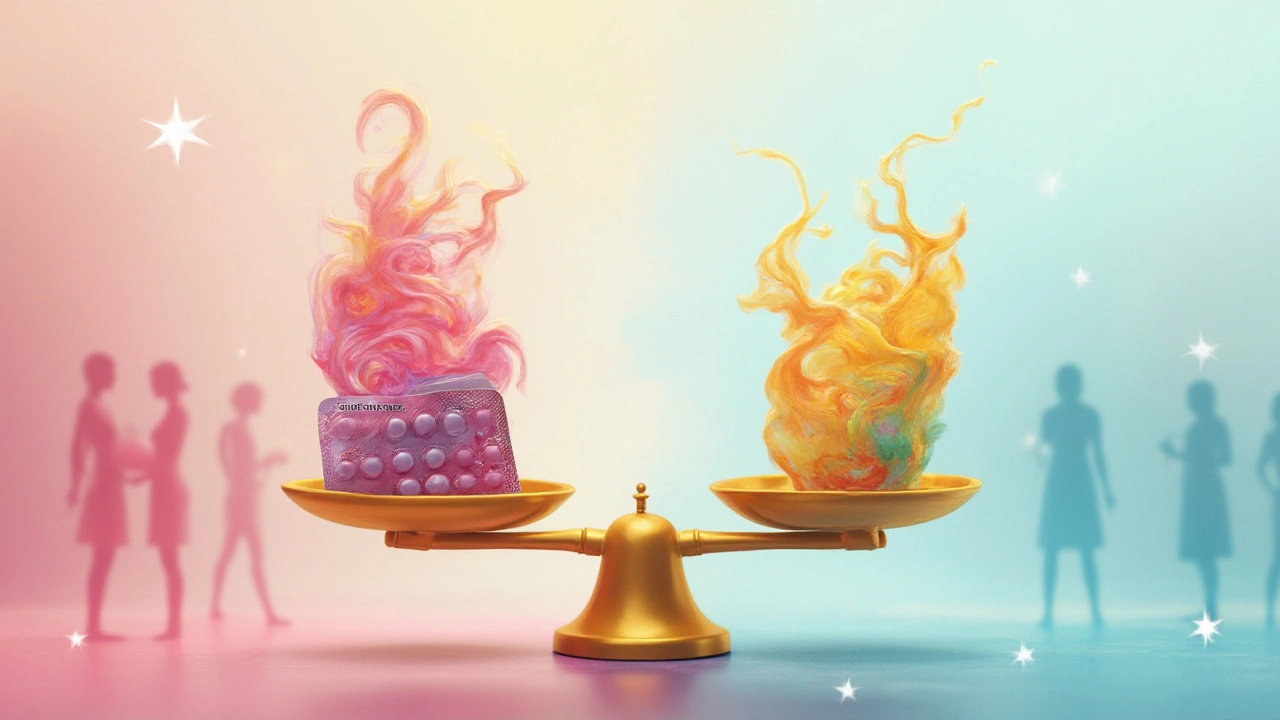You know those days when your body seems to turn against you? Cramps, bloating, headaches, random mood swings—premenstrual syndrome (PMS) has a knack for showing up uninvited. What’s wild is that roughly 75% of women who menstruate will face some PMS symptoms during their reproductive years. For some, it’s the emotional rollercoaster they dread most. For others, the physical discomfort steals the show. But here’s something you might not know: many doctors now use contraception—not just for birth control, but as one of their go-to strategies to calm those monthly symptoms. Sounds odd? Maybe not as much as you think.
Why PMS Symptoms Happen — And How Hormones Are to Blame
Unpredictable cravings, fatigue, irritability—PMS can turn the best week into something out of a bad sitcom. All these emotional and physical curveballs come down to what’s happening with your hormones. Estrogen and progesterone, the main players in your reproductive system, fluctuate naturally during your menstrual cycle. Around the end of your cycle, right before your period, these hormone levels drop rapidly. That massive hormonal dip is what triggers most PMS symptoms.
But it’s never just one culprit. Serotonin, that mood-boosting chemical your brain loves, also dips as hormones drop, which helps explain why you might want to rage at your streaming service for freezing, cry because there’s no ice cream, or snap at a totally innocent friend. Physically, your uterus is getting ready to shed its lining, causing cramps or that heavy, achy feeling in your lower tummy. Some people feel swollen joints, headaches, or bouts of acne—fun, right?
Here’s the kicker: not everyone has the same PMS experience, and family history seems to play a part. Lifestyle factors don’t help: stress, lack of sleep, too much caffeine, or salty foods can kick symptoms up a notch too. The monthly struggle is real for so many, but until recently, most folks had to ride it out with heating pads, over-the-counter painkillers, endless cups of tea, or sheer stubbornness. Enter contraception—the unsung hero.

Contraceptives as PMS Symptom Managers: What Works and Why?
Most people think of birth control pills for, well, birth control. But there’s a bonus: modern contraceptives help keep your hormones on a much shorter leash. Combination birth control pills—those with both estrogen and progestin—essentially even out the monthly rollercoaster by supplying hormones in steady doses. Instead of letting your natural estrogen and progesterone levels bounce all over the place, these pills set a much steadier hormonal pace. For many people, that means milder cramps, less bloating, and fewer wild mood swings.
You don’t have to stick with only pills either. Options like the contraceptive patch or the vaginal ring come into play here, working in much the same way. For people who can’t take estrogen, progestin-only methods (like the minipill or hormonal IUDs) are on the table. Some studies, especially a big review in the "Cochrane Database of Systematic Reviews," have found that drospirenone-containing pills (a particular type of progestin) work especially well for PMS or the more severe PMDD (premenstrual dysphoric disorder).
There’s even evidence that continuous-dosing birth control—where you skip the traditional placebo pills and don’t have a monthly bleed—can work wonders. Zero period, zero PMS (for many anyway). Now, that doesn’t mean contraception is magic for everyone. Some people do fine with traditional pills; others need to change the formulation to see effects. Trial and error is part of the journey, which is why it’s so important to check in with a healthcare provider to find what works best for your specific body and symptoms.
But how does it feel in real life? Women who’ve switched to contraceptives for PMS have reported fewer food binges, less "hormonal rage,” and much easier periods. Some even say their skin calms down, migraines chill out, and their relationships stop being ambushed by tears or irritability right before their period. For athletes or people with super busy jobs, not being sidelined for a week each month is a game changer. So if you see your friend grinning during that week you usually want to hide, they might have gotten their hormones sorted out behind the scenes with a little help from modern birth control.
Quick tip—if you’re struggling with PMS symptoms and curious if contraception could help, keep a symptom diary for a couple of cycles. This helps you and your doctor figure out what’s worth trying. Sometimes it takes a few tries to find the right fit, so patience definitely pays off. And, of course, always weigh the pros and cons—these are real meds, and they can have side effects, but lots of women say the relief from PMS is totally worth it.

Tips, Myths, and What Real Women Wish They’d Known Sooner
Here’s something surprising: the average woman tries up to three different birth control formulations before she finds her sweet spot. That’s because everyone’s hormones have their quirks. Some folks will feel relief from anxiety, breast tenderness, and those "eat everything in the fridge" episodes within the first couple months. For others, it might mean tighter jeans because fluid retention goes up, or spotting between periods until things settle.
Let’s bust a big myth here—contraception will not erase all PMS symptoms for everyone, every time. Some people still deal with headaches or emotional symptoms, though usually less severe. It’s also a myth that long-term birth control use is dangerous for otherwise healthy women. After decades of studies, most healthy women can use hormonal contraception for years without scary side effects. For people with migraines with aura, or certain blood clotting risks, there are tailored options.
Another trick: some women only need contraception for a specific chapter in their lives. Maybe grad school finals are turning hormone havoc into emotional chaos, or a high-stress new job makes regular periods intolerable. Using contraception as a temporary fix is totally on the table. Healthcare pros just want you to have the smoothest months possible, period or no period.
If you’re thinking about trying this route, here are a few things experienced users wish they knew at the start:
- contraception isn’t just about not getting pregnant. It’s about having more energy, steadier moods, and less dread as your period gets closer.
- The first two or three months can be rocky. Spotting, breast soreness, or slight nausea is common—you’re not doing anything wrong. Hang in there, and talk to your doctor if it lasts.
- If you hate taking pills, don’t force yourself. Rings, patches, or IUDs provide the same symptom relief without the daily routine—super handy if you tend to forget meds.
- PMS isn’t just a “mood” problem. Physical symptoms like joint pain, fatigue, and headaches respond just as well to contraceptives as emotional ones do.
- You don’t have to stick with the first thing you try. Doctors are used to tweaking and switching formulas. Make sure to give honest feedback—it really helps fine-tune your plan.
- Pairing contraception with lifestyle changes (think: more sleep, less caffeine, better stress relief) boosts your odds of saying goodbye to brutal PMS months.

Tatiana Akimova
July 10, 2025 AT 00:26Alright, let's just cut to the chase here: contraceptives are like a game-changer for anyone who’s been dragged down by those gnarly PMS symptoms! Seriously, why are we still ignoring this simple fact? It’s not just about preventing pregnancy, it’s about reclaiming some dignity during that weekly chaos.
Balancing hormones really can feel like witchcraft, but contraceptives help level the playing field. You can finally reduce those mood swings, cramps, and that awful bloated feeling. It’s not some optional luxury; it's a necessity for way too many women!
It’s time to shout it from the rooftops! Women deserve to know this stuff so they can demand better healthcare options. This article is a start but come on, let’s get louder!
Hannah Gorman
July 10, 2025 AT 01:26Well, while I do appreciate the enthusiasm here, I must emphasize a certain degree of caution. It's not as simple as 'take a pill and poof! PMS is gone.' Hormonal contraceptives can undoubtedly help balance hormones, but they are not a silver bullet. There are so many nuances—individual hormone sensitivity, pre-existing conditions, and potential side effects—that must be kept in mind when considering this option.
Moreover, it seems critical that we approach this with a serious, educated mindset rather than just a one-size-fits-all hype. Women deserve comprehensive information that includes both benefits and risks, not just cheerleading. That’s how real empowerment is achieved.
Dan Burbank
July 10, 2025 AT 02:26To echo some insightful points here, I would add that the discourse around contraceptives and PMS often lacks a critical intellectual depth. Yes, hormonally balancing contraceptives do offer relief for many, but the sheer lack of personalized medicine in this domain is rather lamentable.
Contraceptives act as blunt instruments, and while they mitigate symptoms, the underlying individual biochemical symphony is still misunderstood by much of contemporary medicine. It becomes paramount that more advanced, nuanced therapeutic approaches be devised rather than the broad strokes we currently rely on.
Consequently, I would caution anyone to view contraceptives as a temporary symptom reliever rather than a comprehensive solution.
Anna Marie
July 10, 2025 AT 03:26This post definitely touches on an important topic. I think that contraceptives have helped many women I know personally who struggle monthly, but it's really crucial depending on individual health history. From what I've seen, proper consultation with a healthcare provider makes all the difference.
It’s also worth mentioning that while contraceptives can reduce PMS symptoms by evening out hormone levels, they’re part of a broader approach – diet, exercise, and stress management all play critical roles. So it shouldn't be viewed as a standalone fix but a piece of the puzzle.
Does anyone here have experiences with particular contraceptive types that helped more or less with PMS? That kind of firsthand insight might be helpful for folks reading.
Calandra Harris
July 10, 2025 AT 04:26Forget the delicate musings about hormones, let’s be honest: hormonal contraceptives are basically tools for controlling women's bodies under the guise of relief from PMS. The whole 'balancing hormones' hype is just a neat phrase to sell pills and keep the system comfortable.
Instead of really understanding and respecting women’s natural cycles, society forces pills down throats like candy. The answer isn’t more synthetic chemicals messing with our biology but advocating for natural body wisdom and addressing root causes! Why is that so hard to grasp?
Wake up, people. PMS is not a disease to be masked but a natural sign. Real solutions come from holistic lifestyle changes, not just popping contraceptives as a silver bullet.
Abdulraheem yahya
July 10, 2025 AT 05:26Hey all, coming in from the other side of the world, it’s fascinating how this issue resonates so universally. I have friends here who have experimented with different contraceptive methods to ease their PMS symptoms, and the results they report can be quite mixed but generally positive.
It’s always a balancing act, isn’t it? Finding the right contraceptive that suits both the mind and body—and considering cultural attitudes towards these methods adds another layer of complexity. I’m curious how much access to varied contraceptive options influences women’s experiences globally?
And while hormonal balance is central, I definitely agree with previous commenters that lifestyle and emotional support systems hugely contribute to managing PMS symptoms.
Akhil Khanna
July 10, 2025 AT 06:26This is a valuable discussion! From my observation, education about contraceptives must include their dual roles—both in family planning and in symptom management. That said, misinformation often clouds judgment, so access to accurate knowledge must be prioritized worldwide.
Also, let's not forget the great role played by emotional and community support when dealing with PMS—it’s not just biology but also holistic wellbeing. Sharing personal testimonials enhances understanding beyond clinical data, and I encourage everyone to keep that in mind.
Anyone tried combining contraceptive methods with dietary changes or supplements that worked well? I’d love to hear about synergistic approaches.
Hannah Gorman
July 10, 2025 AT 07:26Addressing some comments here, especially regarding the necessity to respect the natural cycle: I completely agree natural bodily wisdom is crucial. However, for some women, PMS symptoms are debilitating, and contraceptives can offer a seriously needed reprieve.
The goal is not to erase nature but to empower women with options that can improve quality of life. It’s about informed choice and personalized healthcare, not blanket solutions or forced compliance.
Ultimately, every approach must listen to the individual woman’s needs and experiences. That inclusion and respect are where true progress lies.